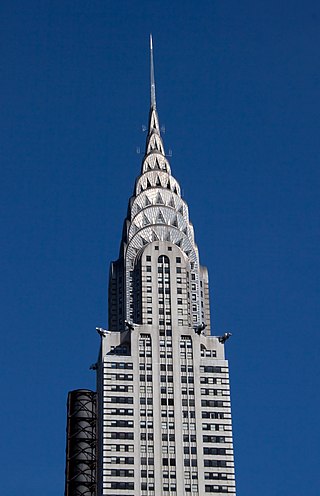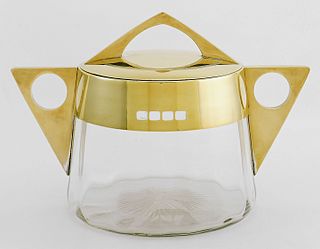
Art Deco, short for the French Arts décoratifs, is a style of visual arts, architecture, and product design, that first appeared in Paris in the 1910s, and flourished in the United States and Europe during the 1920s to early 1930s. Through styling and design of the exterior and interior of anything from large structures to small objects, including how people look, Art Deco has influenced bridges, buildings, ships, ocean liners, trains, cars, trucks, buses, furniture, and everyday objects including radios and vacuum cleaners.

Art Nouveau is an international style of art, architecture, and applied art, especially the decorative arts. It was often inspired by natural forms such as the sinuous curves of plants and flowers. Other characteristics of Art Nouveau were a sense of dynamism and movement, often given by asymmetry or whiplash lines, and the use of modern materials, particularly iron, glass, ceramics and later concrete, to create unusual forms and larger open spaces. It was popular between 1890 and 1910 during the Belle Époque period, and was a reaction against the academicism, eclecticism and historicism of 19th century architecture and decorative art.

The Wiener Werkstätte, established in 1903 by the graphic designer and painter Koloman Moser, the architect Josef Hoffmann and the patron Fritz Waerndorfer, was a productive association in Vienna, Austria that brought together architects, artists, designers and artisans working in ceramics, fashion, silver, furniture and the graphic arts. The Workshop was "dedicated to the artistic production of utilitarian items in a wide range of media, including metalwork, leatherwork, bookbinding, woodworking, ceramics, postcards and graphic art, and jewelry." It is regarded as a pioneer of modern design, and its influence can be seen in later styles such as Bauhaus and Art Deco.

The University of Applied Arts Vienna is an arts university and institution of higher education in Vienna, the capital of Austria. It has had university status since 1970.

The Vienna Secession is an art movement, closely related to Art Nouveau, that was formed in 1897 by a group of Austrian painters, graphic artists, sculptors and architects, including Josef Hoffman, Koloman Moser, Otto Wagner and Gustav Klimt. They resigned from the Association of Austrian Artists in protest against its support for more traditional artistic styles. Their most influential architectural work was the Secession exhibitions hall designed by Joseph Maria Olbrich as a venue for expositions of the group. Their official magazine was called Ver Sacrum, which published highly stylised and influential works of graphic art. In 1905 the group itself split, when some of the most prominent members, including Klimt, Wagner, and Hoffmann, resigned in a dispute over priorities, but it continued to function, and still functions today, from its headquarters in the Secession Building. In its current form, the Secession exhibition gallery is independently led and managed by artists.

Koloman Moser was an Austrian artist who exerted considerable influence on twentieth-century graphic art. He was one of the foremost artists of the Vienna Secession movement and a co-founder of Wiener Werkstätte.

Winold Reiss was a German-born American artist and graphic designer. He was born in Karlsruhe, Germany. In 1913 he immigrated to the United States, where he was able to follow his interest in Native Americans. In 1920 he went West for the first time, working for a lengthy period on the Blackfeet Reservation. Over the years Reiss painted more than 250 works depicting Native Americans. These paintings by Reiss became known more widely beginning in the 1920 and to the 1950s, when the Great Northern Railway commissioned Reiss to do paintings of the Blackfeet which were then distributed widely as lithographed reproductions on Great Northern calendars.

The Stoclet Palace is a mansion in Brussels, Belgium. It was designed by the Austrian architect Josef Hoffmann for the Belgian financier Adolphe Stoclet. Built between 1905 and 1911 in the Vienna Secession style, it is located at 279–281, avenue de Tervueren/Tervurenlaan, in the Woluwe-Saint-Pierre municipality of Brussels. Considered Hoffman's masterpiece, the residence is one of the 20th century's most refined and luxurious private houses.
Karl Emanuel Martin "Kem" Weber (1889–1963) was an American furniture and industrial designer, architect, art director, and teacher who created several iconic designs of the Streamline style.

Oskar Strnad was an Austrian architect, sculptor, designer and set designer for films and theatres. Together with Josef Frank he was instrumental in creating the distinctive character of the Wiener Schule der Architektur. He stood for a modern concept of "living" for all people, planned and built private dwelling-houses, designed furniture, created ceramics and watercolours and designed sets and props for stage plays and films.

Paul T. Frankl, an Art Deco furniture designer and maker, architect, painter and writer from Vienna, Austria, was the son of a wealthy real estate speculator.

Josef Hoffmann was an Austrian-Moravian architect and designer. He was among the founders of Vienna Secession and co-establisher of the Wiener Werkstätte. His most famous architectural work is the Stoclet Palace, in Brussels, (1905–1911) a pioneering work of Modern Architecture, Art Deco and peak of Vienna Secession architecture.
Ernst Schwadron (1896–1979) was an Austrian architect and interior designer.
Werkstätte Hagenauer Wien - (wHw) - was a family business in Vienna that produced fine, handcrafted objects for decoration and use over its nearly ninety-year history. The workshop closed in 1987 but the company's retail premises, opened in 1938 on Vienna's Opernring, survives today as a museum and shop.

Gisela Falke Von Lilienstein was an Austrian designer who designed ceramics, glassware, jewelry, lighting, and furniture for the Wiener Werkstätte. Her work was exhibited in Vienna Secessionist exhibitions and international expositions.

Josefine Pola Stout was an American designer best known for creating fine woolen fabrics. Born in Stryj, she studied with Josef Hoffmann at the Kunstgewerbe Schule in Vienna, and designed for the Wiener Werkstätte before she immigrated to the United States in 1925 with her first husband, architect and designer Wolfgang Hoffmann. Wolfgang and Pola Hoffmann became a prominent interior design team that contributed to the development of American modernism in the early 20th century. They dissolved their successful partnership in 1932, when she married popular mystery author Rex Stout. Pola Stout was an influential textile designer after her second marriage. She was executor of Rex Stout's literary estate after her husband's death in 1975.
The American Union of Decorative Artists and Craftsmen (AUDAC) was an American society of designers and decorative artists that was active from 1928 until the early 1930s. The group aimed to bring modern principles of design, such as those promoted in Europe by the Wiener Werkstätte and the Bauhaus, to decorative arts in the United States.

The Art Nouveau movement of architecture and design first appeared in Brussels, Belgium, in the early 1890s, and quickly spread to France and to the rest of Europe. It began as a reaction against the formal vocabulary of European academic art, eclecticism and historicism of the 19th century, and was based upon an innovative use of new materials, such as iron and glass, to open larger interior spaces and provide maximum light; curving lines such as the whiplash line; and other designs inspired by plants and other natural forms.
The Gallia family Hoffman apartment collection is a set of furniture and decorative objects that are the surviving Vienna Secession style contents of the 1913 apartment of wealthy Austrian businessman Moritz Gallia and his wife and Hermine, mostly designed by leading architect and designer Josef Hoffman. When the Gallia's children had to flee the Anschluss with Nazi Germany in 1938, they brought what remained with them to Australia, a place 'as far away as they could get', where it was subsequently purchased in 1976 by National Gallery of Victoria, and pieces have been on permanent display since 1984.

Eduard Josef Wimmer-Wisgrill was an Austrian industrial designer, architect, and fashion designer. He was active in the first half of the 20th century. Wimmer is best known for his work in jewelry and garments for the Wiener Werkstätte, as well as for his contributions to the field of modern architecture.



















